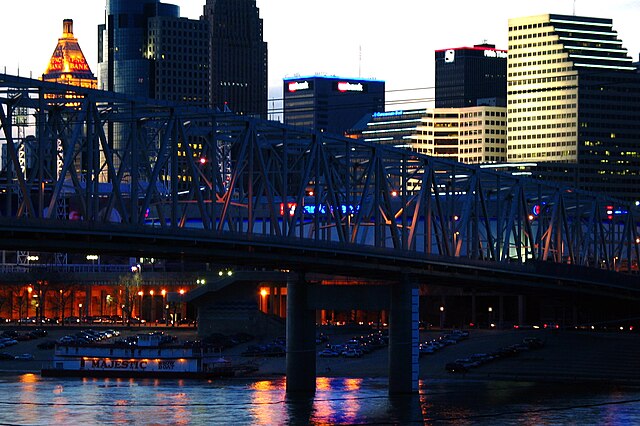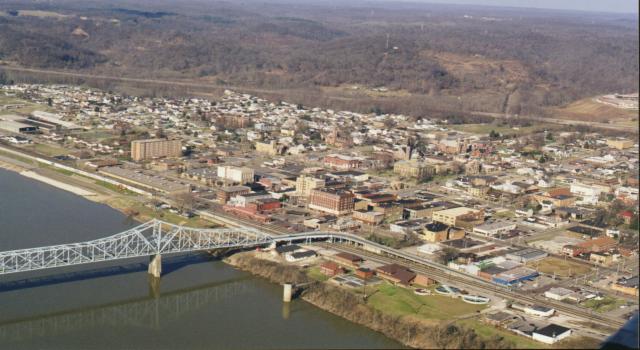Blue Highways: The Ending
Unfolding the Map
 It's the end of the road for our Blue Highways adventure. Even though the book ends with William Least Heat-Moon gassing up Ghost Dancing at New Harmony, Indiana for the final run to Columbia, Missouri and home, we know that he made it because he subsequently wrote other books. Thank you, all of you Littourati, for reading my posts during my 2½ year journey through the book. I'll be back in a few weeks with my next mapping project, whatever that may be! In the meantime, here is the completed Blue Highways map!
It's the end of the road for our Blue Highways adventure. Even though the book ends with William Least Heat-Moon gassing up Ghost Dancing at New Harmony, Indiana for the final run to Columbia, Missouri and home, we know that he made it because he subsequently wrote other books. Thank you, all of you Littourati, for reading my posts during my 2½ year journey through the book. I'll be back in a few weeks with my next mapping project, whatever that may be! In the meantime, here is the completed Blue Highways map!
Book Quote
"The circle almost complete, the truck ran the road like the old horse that knows the way. If the circle had come full turn, I hadn't. I can't say, over the miles, that I had learned what I had wanted to know because I hadn't known what I wanted to know. But I did learn what I didn't know I wanted to know....
"....The pump attendant, looking at my license plate when he had filled the tank, asked, 'Where you coming from, Show Me?'
"'Where I've been.'
"'Where else?' he said."
Blue Highways: Part 10, Chapter 4

Columbia, Missouri : The Ending
It's with some bittersweet feelings that I begin this post. On May 17th, 2010 I started this project to map and to explore my thoughts. feelings and emotional reactions to Blue Highways. The concept remained simple, and followed neatly from my previous explorations into On the Road. I would map Blue Highways, and write about whatever moved me from the reading. This would provide a geographical map of Blue Highways, and also a map for me (and whomever else was interested) of my inner emotional geography and thought process.
Little did I know that this project would consume 2½ years, constitute 375 mapped points and 318 posts. I could have never fathomed that, since I wrote a rough average of 1000 words per essay, I would easily write at least 318,000 words or more. Nor did I know just what depths of my emotions and my knowledge, and in many cases my curiosity, I would sound in my journey through Blue Highways.
The fruits of my project have been, for me, overwhelmingly positive. I feel that I've become a better writer and essayist, though I realize that the quality most likely varies from post to post. I also loved immersing myself so completely into a book. What the reader has seen in Littourati has been my thoughts and feelings that have been dredged up through William Least Heat-Moon's skillful and polished prose.
Littourati has also become more well-known on the internet. Someone, I have no idea who, has put a link to Littourati on the Blue Highways Wikipedia page. I've received the occasional comment of support and visits from all over the world. I can only hope that what I've put down in these Blue Highways posts resonates with readers. I've also added some additional small embellishments, like the "Musical Interlude" where I insert songs that I believe relate to the posts, photos of the towns and pictures of symbols of the state.
I'm very thankful to William Least Heat-Moon for writing Blue Highways and providing me with so much inspiration. If he knows about Littourati and my efforts to map his book, I hope he approves. I have never meant to diminish Blue Highways, but to celebrate it, and I hope that is evident.
My life's journey has progressed in the time since started mapping Blue Highways. My job has changed, I'm buying a house for the first time, and there have been numerous joys and heartbreaks that I've experienced. In other words, life has occurred. One thing that has helped me through these ups and downs has been knowing that 2-3 times a week, I had posts on Blue Highways to do. You, as the reader, have come along with me through some of those ups and downs, just as I have accompanied William Least Heat-Moon, circa 1980 or so, on his journey. I don't know if I feel I've come full circle, because like he writes, I didn't know what I wanted to know. That's been my joyful discovery during this process - those things I didn't know that I wanted to know.
What will I do, now that Blue Highways is over? First, I have some unexpected, pressing personal business to attend to. Then I must update my knowledge on Google Maps because its version has changed during my Blue Highways effort and I want the next project to utilize the latest version. And finally, I need to pick my new project. I have three in mind:
- Neil Gaiman's American Gods, where I would map the physical and spiritual journey of the main character Shadow (as well as my own feelings on spirituality and religion).
- Jules Verne's Around the World in 80 Days in conjunction with pioneering female investigative journalist Nellie Bly's effort to beat Phileas Fogg's (fictional) record in her around the world effort in the late 1800s, and Elizabeth Bisland's efforts to beat Nellie Bly at the same time as Bly's journey by traveling in the opposite direction.
- Mark Twain's Life on the Mississippi in conjunction with Eddy Harris' solo trip by canoe down the Mississippi in his book Mississippi Solo.
So many possibilities! If you have a preference, or a journey that I haven't thought of, please feel free to leave a comment and let me know what you think. I want to be back with my next project in late February.
Finally, I want to thank everyone who has visited this site. Littourati would be nothing if you didn't visit. At last count, the average is about 125 unique people per day, and about 231 hits per day. I still find it astounding that technology allows one to reach so many people now with just a click of a mouse. As you might have gathered in many of my posts, it's the blessing and curse of modern technology. But, in this case, I have only found blessings.
Musical Interlude
I will end the Blue Highways posts with a song I just discovered: Eddie Vedder's End of the Road from the Into the Wild soundtrack. I was leery, given how Into the Wild ends, but the lyrics really fit the end of Blue Highways.
If you want to know more about Blue Highways or William Least Heat-Moon
William Least Heat-Moon has written many other fine books since Blue Highways. I was enchanted by PrairyErth, an in-depth look at Chase County, Kansas. He also wrote another road travel book called Roads to Quoz, and a water-travel book called River Horse. Please consider reading more from this accomplished author.
Audio interviews with William Least Heat-Moon
Booknotes interview with William Least Heat-Moon
In Depth with William Least Heat-Moon
Onpoint interview with William Least Heat-Moon
University of Missouri Museum of Anthropology: Ghost Dancing (the Blue Highways van)
Wikipedia: William Least Heat-Moon
WorldHum interview with William Least Heat-Moon
Next up: Wherever the Journey Takes Us!




 Monday, February 4, 2013 at 4:46PM
Monday, February 4, 2013 at 4:46PM






